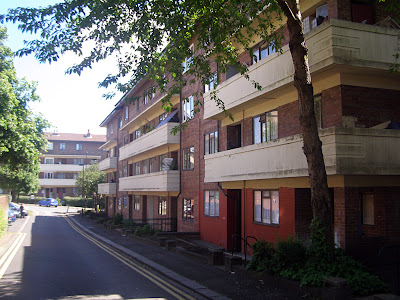Studentcastle Revisited
It ought not to work; work in the sense of being more than a collection of ill-judged or considered solutions to a problem. After all, who cares? Along the front side of Newcastle Quayside a set of facades has done well enough. Behind these, piled into a narrow strip between two main roads, what is to be gained or lost?
I do not know if such considerations played any part in planning thinking. What I sense (rather than know for a fact) is that what has happened has, in some haphazard way produced something more than bleakness. Unintentional it maybe but it demonstrates something about the way cities grow and overpower mere plans or concepts.
I walked about on that day surprised at my own surprise. I dodged from patch of shade to patch of shade in the standing heat of a hot day. Traffic, windows often down, stopped and flowed at the lights packed like a forest around the major junctions, colours hard to read in the glare. People, not all students I judged, sauntered past me as if they were expecting nothing less than Mediterranean skies. Cafés offered more than snacks and cold drinks; they gave shelter. I noted one or two enterprises that have emerged to take control of the potential offered by several hundreds, perhaps a thousand now, of students resident in the halls that have been constructed around and about. Some of the new buildings are also new city flats and apartments for residential clients.
Original stone parapet over the East Coast Main Line. 19th c.
Here, beside the East Coast Main Line, rises a brightly adorned block, like as if IKEA had gone into property development. On the other side of the bridge stands the blank walls of the first wave of apartments to go up here abouts. Jump forward from De Stijl to Minimalism; the high security prison variety.
Not that variety had much input. In front of me now stands a building that looks at first glance to be a resurrected warehouse. The colour is deep co-coa brown. It dawns on inspection that this is a fine homage to the district's roots in commerce. It would look good anywhere. It sits on a triangular site that it owns as of right.
Opposite, on the farther side of the street in deep shadow, is a restored building, sadly as of today, unoccupied. Both have true class, and turn this stretch of Melbourne Street into a 'place'. Standing there in the deep shadows cast by the intense sunlight, a feeling of having arrived somewhere was palpable.
I wandered on and found an authentic Victorian or Edwardian corner building I suspect was once something more than it is now, bathed in that intense light. A survivor.
I went through a series of side streets off the main roads. Here there are earlier public housing schemes, judging from their design, dating from the 50s or early 60s. Trees that must have been under threat from the date they were planted out have come through and now cast shadows over pavements, stucco walls and balconies. An old man (well, older than me) called down to a friend (neighbour?) who was offering to run an errand. Peace and quiet reigned. Perhaps it was just too much effort to make noise.
Then I walked up a kind of courtyard to a parking place where plantins had grown up through paving slabs and stood huge and flowering in the heat of midday; I was reminded of walking in Spain; there, even the parched places had flowers.
The western curve of St Dominic's transept was high above me, a glimpse of some Renaissance inspiration.
And then I found myself cooling under the spreading branches of a huge and luxurious fig tree.
Images, together with descriptions for this walk, are to be found on the site's Flickr feed.









No comments:
Post a Comment